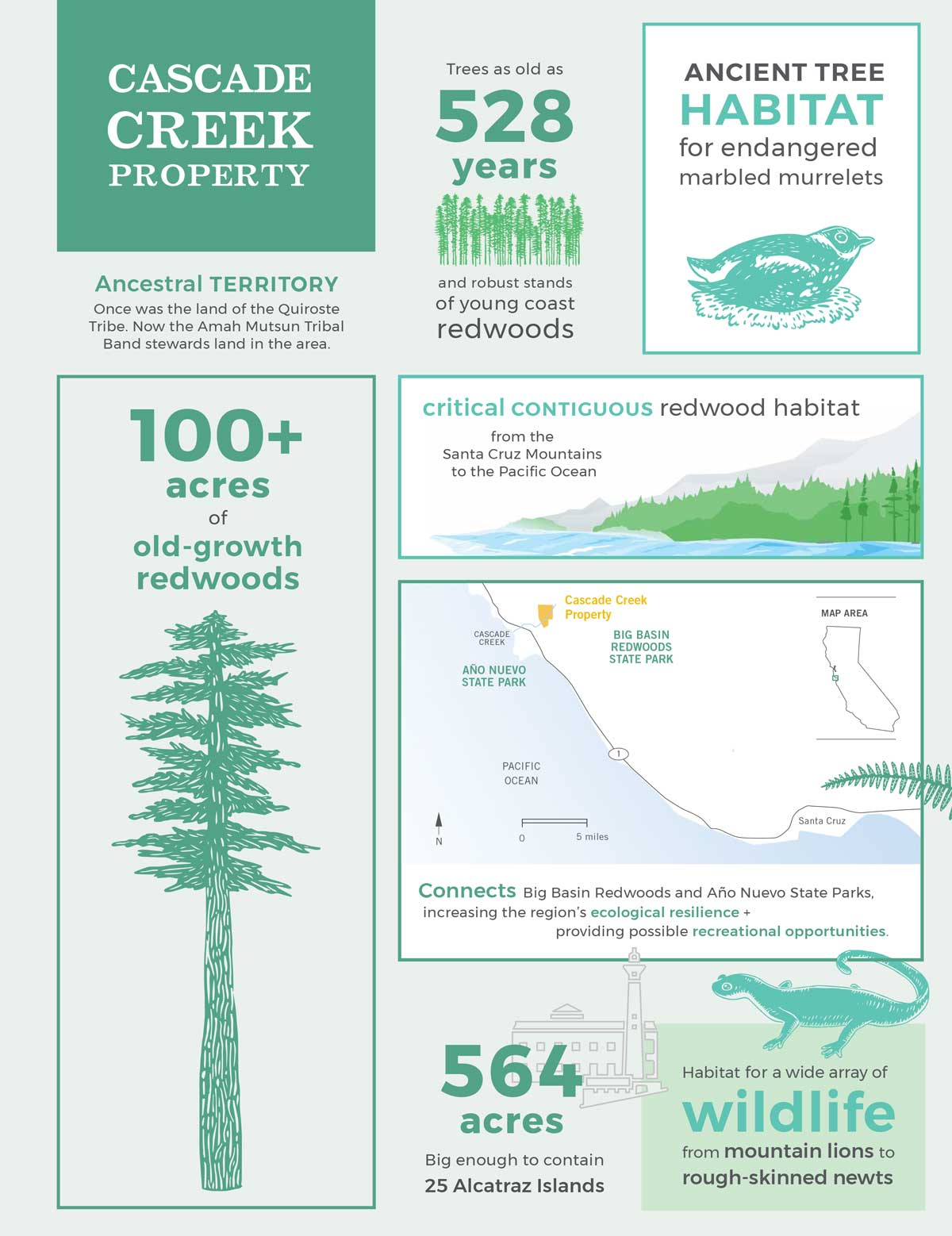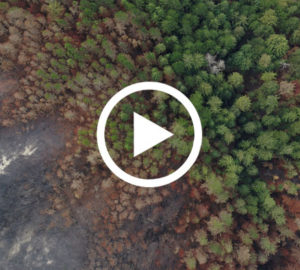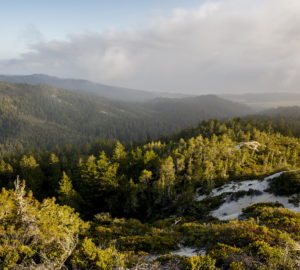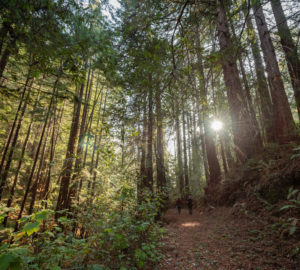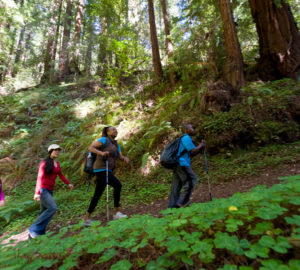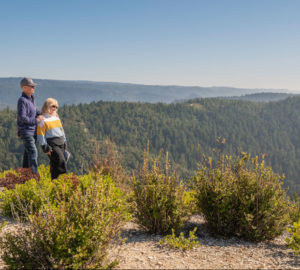Save the Redwoods League reached our fundraising goals and expects to finalize the purchase of this breathtaking coast redwood forest in the coming weeks, connecting the Santa Cruz Mountains to the Pacific Ocean.
Vibrant old- and second-growth forest sustains region’s ecological resilience
Nestled between Big Basin Redwoods and Año Nuevo State Parks, on the ancestral territory of the Quiroste Tribe, a property called Cascade Creek evokes a lost era of primeval forests that once graced the entire San Francisco Bay Area.
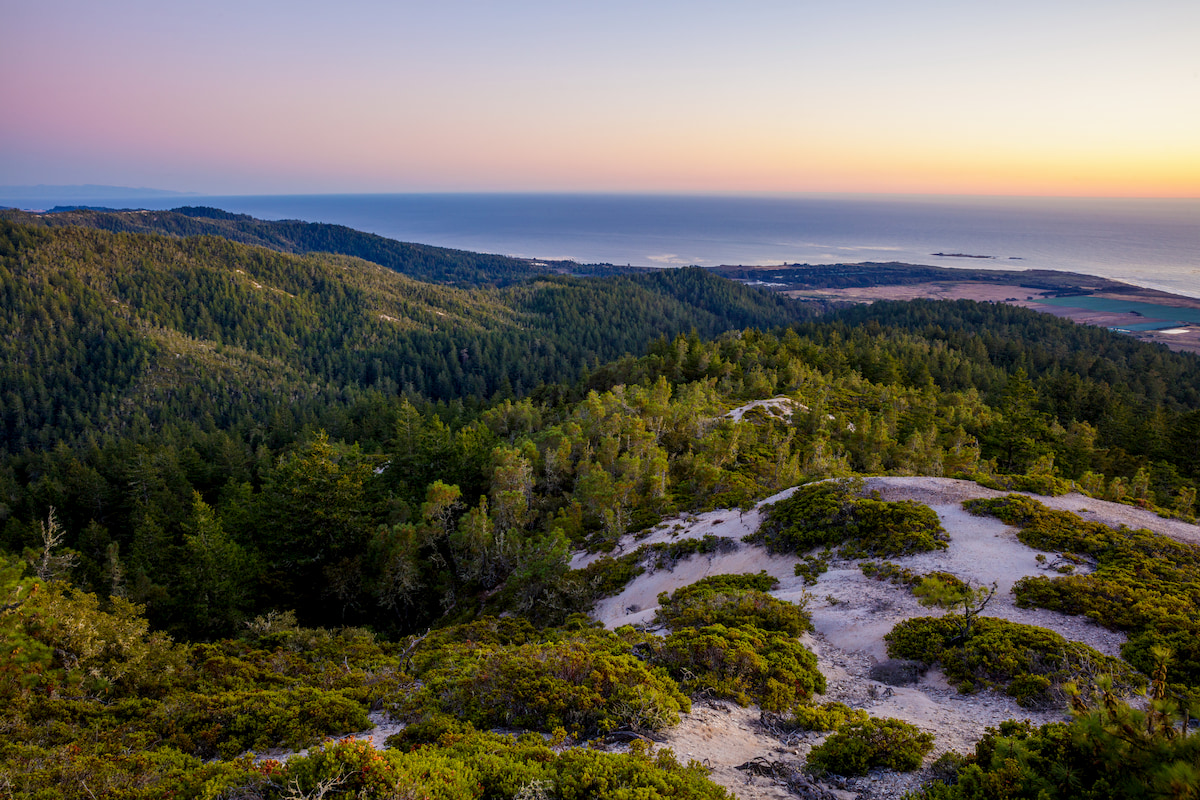
Off the iconic California State Route 1, ancient coast redwoods and mature second-growth trees shade the property’s namesake creek and a lush understory blanketed with western swordferns, trilliums, and redwood sorrels. Redwoods young and old tower high on the upper slopes, sharing the steep terrain with lofty Douglas-firs and mature madrones. From a ridge, a view of the verdant forest and azurean Pacific Ocean embodies the importance of this 564-acre property; it is a regional keystone that connects ecosystems from the Santa Cruz Mountains to the sea.
“Eight years ago, the Holmes family called me up, as they have in the past, and said, ‘Catherine, let’s save some redwoods,’” recalled Catherine Elliott, Senior Manager of Land Protection for Save the Redwoods League.
Owned by the Holmeses since 1978, Cascade Creek’s old-growth forests have thrived under the family’s stewardship. Thanks to our generous supporters, the League reached the public and private fundraising goal of $9.6 million to purchase the property. The purchase, which we expect to finalize in the coming weeks, will forever safeguard the forest from development and create continuous protected redwood habitat from the Santa Cruz Mountains to the Pacific Ocean.
Safeguarding Rich Habitat
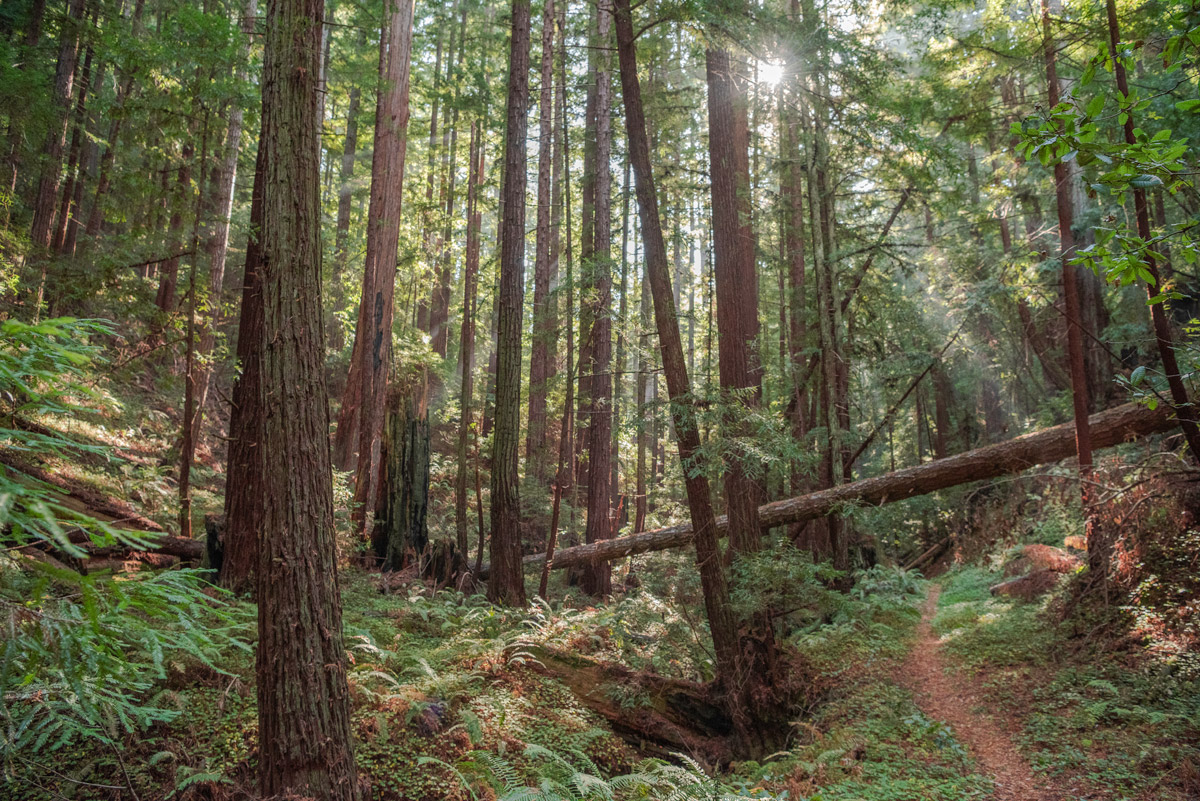
By connecting Big Basin Redwoods with the coastal prairies, wetlands, dune fields, and ocean bluffs of Año Nuevo, Cascade Creek provides contiguous habitat for myriad native wildlife species that traverse this landscape: mountain lions, black-tailed deer, bobcats, coyotes, gray foxes, ringtails, and rough-skinned newts, as well as raptors and songbirds. Listed as threatened under the federal Endangered Species Act and endangered under California’s Endangered Species Act, marbled murrelets have been spotted in the area. The property’s 100 acres of ancient redwoods may provide nesting habitat for these elusive seabirds.
In addition, League scientists at Cascade Creek observed exceptionally high plant diversity, including lush western swordferns, plants that researchers have used as indicators of how drought is affecting the forests.
Scientists of the League’s Redwoods and Climate Change Initiative climbed into the canopy and studied four of the old trees on the property, aging them between 420 and 528 years old. Researchers also found that the mature second-growth forest here is recovering remarkably fast. There’s a 100-year-old tree that is larger in trunk diameter and crown size than the oldest tree studied, and nearly as tall. These findings are a testament to the forest’s incredible resilience to climate change and other impacts caused by humans.
Richard Campbell, the League’s Director of Restoration, has determined that very little ongoing restoration will be needed to ensure the ecological health of the property.
“The well-spaced second-growth stands are growing rapidly on stable soils with adequate nutrients and water,” Campbell said. “They are developing the qualities of the older forests already.”
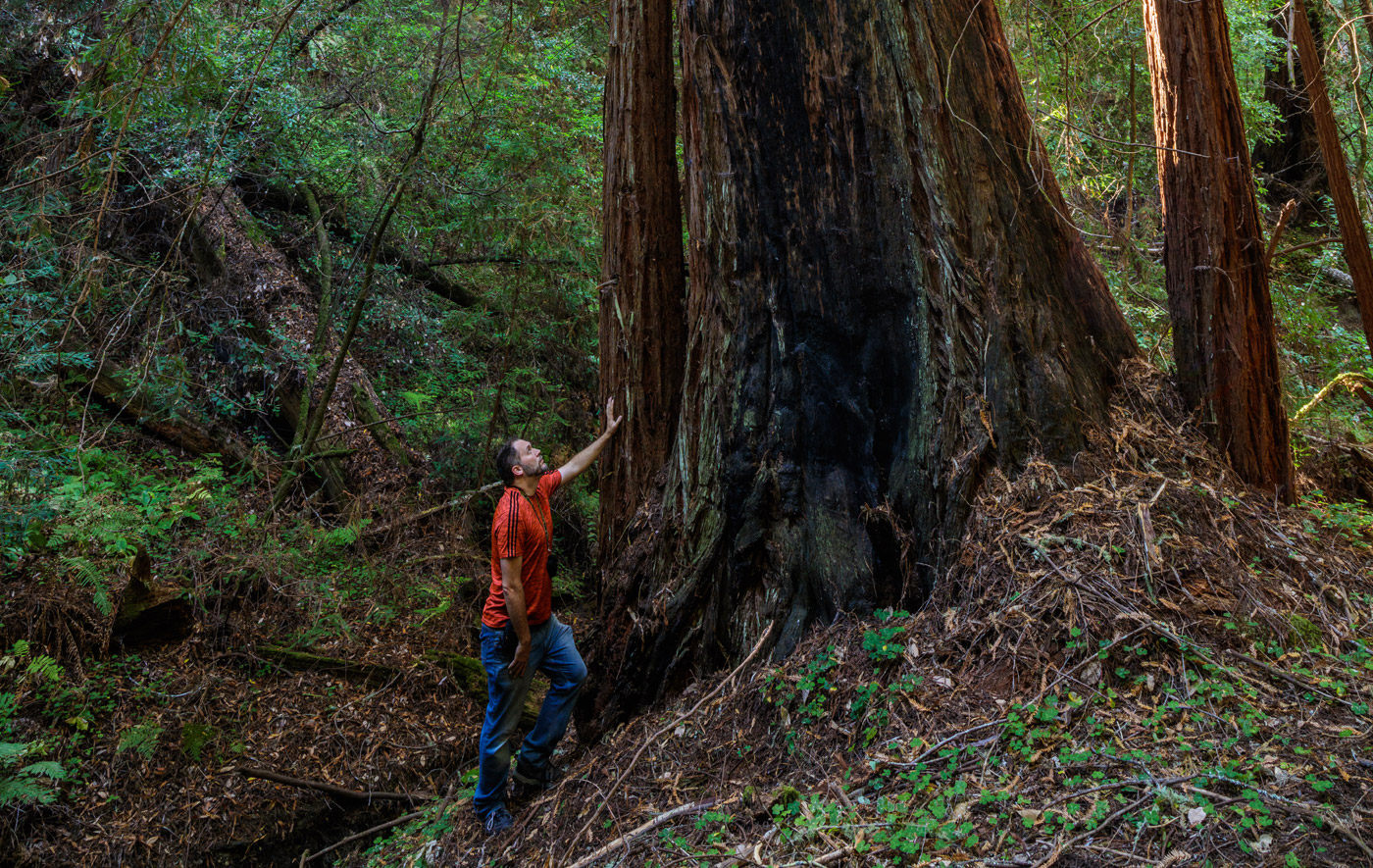
Indigenous Stewardship
While there are no known surviving members of the Quiroste Tribe—the first people and historical stewards of the area—the lands surrounding Cascade Creek continue to be looked after by the neighboring Amah Mutsun Tribal Band. The tribe has been working for years to relearn their ancestral stewardship practices.
“Each generation, every day, we work to try and restore traditional indigenous knowledge,” said Valentin Lopez, Chairperson of the Amah Mutsun. “Our people learn how to take care of all the resources. But what they learn first and foremost is that Creator made the world perfect. We understand that it is our responsibility to keep it sacred, and to not try and dominate it or destroy it or change it.”
The League had the honor of working with the Amah Mutsun Land Trust to conduct an archaeological and ethnobotanical survey of Cascade Creek. No habitation sites or artifacts were found, but there are culturally significant landscape features, as well as ethnobotanical resources (plants used traditionally by local tribes), including coast live oak, golden chinquapin, and huckleberry. Surveyors also found pygmy redwoods along the north-south ridgeline down the center of the property where the soil is sandier and drier. These unusually small redwoods are generally fewer than seven feet tall but could be several decades old.
Protecting the tribe’s cultural resources such as their food, medicine, and basketry plants, is a priority, Lopez said.
“We hope we can work with Save the Redwoods League to protect our important cultural resources on all of their properties. We must restore traditional cultural stewardship and our sacred relationships to these lands so together we [and the League] can fulfill our obligation to take care of Mother Earth and all living things.”
The Heartland of the Southern Redwood Forest
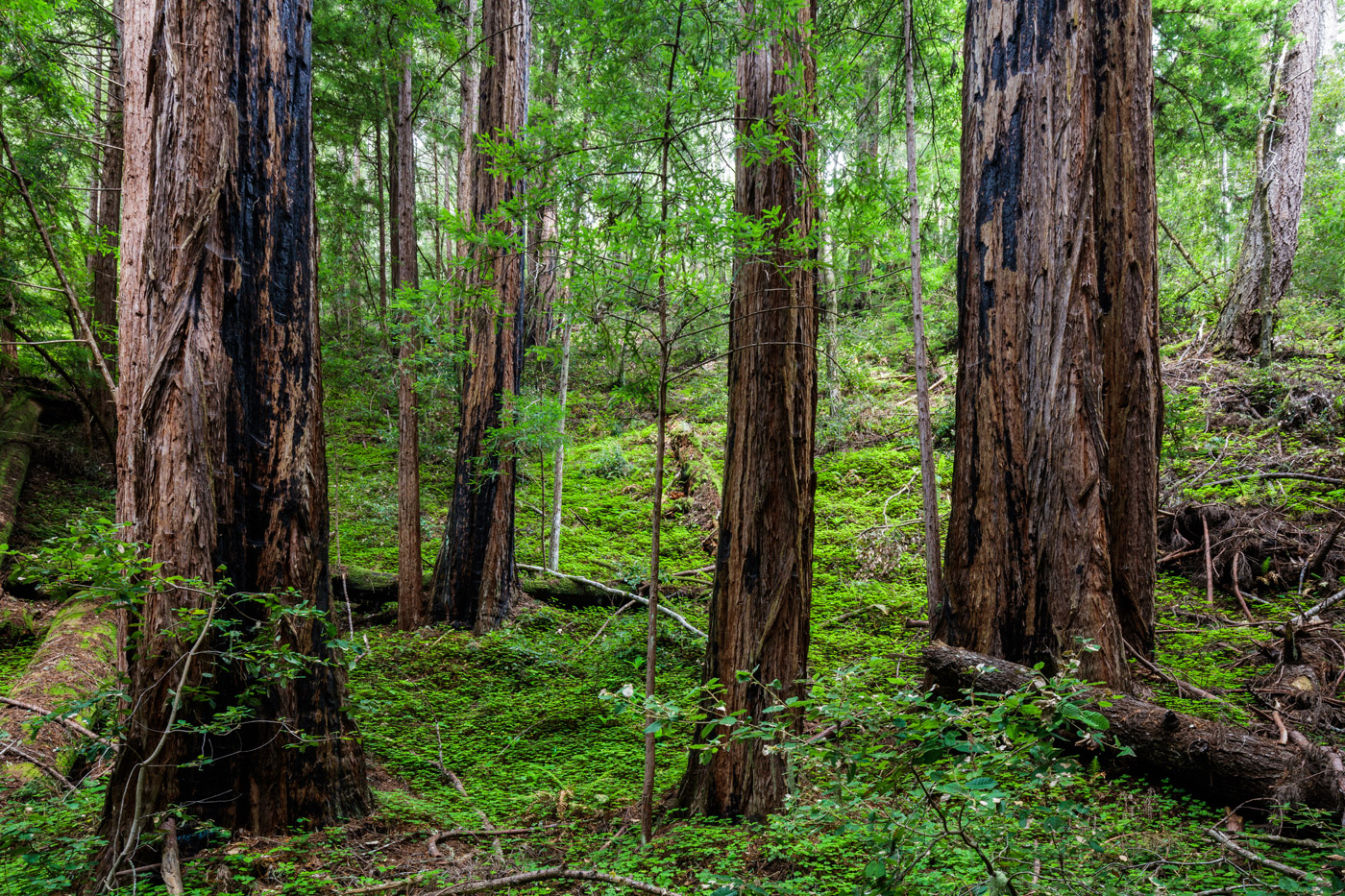
In the future, the League plans to transfer Cascade Creek to California State Parks or another permanent steward. Public access is a priority, especially on a property so easily accessible to San Francisco Bay Area communities. Californians showed how much they valued nature in March, when they packed parks during the state’s shelter-in-place response to the coronavirus. The League anticipates developing enhanced recreational opportunities for visitors to the Santa Cruz Mountains. Visitors will be able to hike from Año Nuevo State Park on the inland side of State Route 1 (also known as Highway 1) and up into the forest along Cascade Creek. The creek flows down through the forest and over the 50-foot Cascade Falls just south of the property on state park land.
“It’s a piece of property that should be a part of the state parks,” said Larry Holmes, who, with his wife Bronia led his family’s efforts to protect the forest. “We’ve known that for many years. And then when you realize that 95 percent of the world’s old-growth coast redwoods were cut, it’s very important to us to save the redwood trees.”
The League has worked with the Holmes family in the past to protect two other spectacular redwoods properties in the nearby Peters Creek and Boulder Creek watersheds. In total, the League has safeguarded more than 17,000 acres of redwood lands in the Santa Cruz area, including 8,500-acre San Vicente Redwoods.
These efforts have helped to protect the largest stands of ancient redwoods south of San Francisco; allowed for the restoration of second-growth redwood forests; provided critical connections between redwood parks and preserves; enhanced habitat for a number of imperiled species; and greatly expanded outdoor recreational opportunities.
THANK YOU TO OUR SUPPORTERS
We reached our fundraising goal of $9.6 million for Cascade Creek thanks to significant gifts from the Gordon and Betty Moore Foundation, our project partner Peninsula Open Space Trust (POST), and League Councilor Ralph Eschenbach and his wife Carol Joy Provan. Ralph and Carol matched dollar for dollar up to $500,000 all gifts to Cascade Creek; they were joined by an anonymous donor who matched gifts dollar for dollar up to $100,000, tripling the impact of gifts made in the final days of the fundraising campaign. In addition to this generous support from League partners and donors, the Holmes family has made a land value donation of more than $1 million, and the California State Coastal Conservancy is providing $2.5 million for the acquisition.
“This is a very significant conservation acquisition,” said Dan Winterson, who manages the Bay Area Conservation Program at the Moore Foundation. “We are very happy to support the excellent work of Save the Redwoods League in protecting Cascade Creek, which safeguards a spectacular forest with important wildlife benefits.”
Walter T. Moore, President of POST, added, “When opportunities of this magnitude come along, we are always ready to support them. This has been a unique partnership with the Holmes family, the League, and all of the other funders. Adding another 500-plus acres of protected redwoods in this region is key to our mission and makes all of us at POST and our donors very grateful and proud.”
In these uncertain times, as we recover from an unprecedented public health and economic crisis, we again take our cues of strength and resilience from the redwoods. The pandemic, and the extensive measures to respond to it, have put in stark relief the need for more parks, healthier forests, and a better balance with our natural world. Investments in our parks and forests make our communities healthier and stronger.
The protection of Cascade Creek is an initiative of Forever Forest: The Campaign for the Redwoods, a comprehensive campaign launched by Save the Redwoods League in January to support our ambitious vision for the next century. With a goal of raising $120 million by 2022, the Forever Forest Campaign will make possible the protection of entire landscapes through large-scale, strategic land acquisitions; restoration of young redwood forests to become the old-growth forests of the future; and the connection of all people with the beauty and power of the redwoods through transformational park experiences.
“The main reasons we wanted to save this property are for future generations, for my grandchildren, their children, and for the planet,” said Bronia Holmes. “It’s a good feeling knowing that it’s forever preserved.”
CASCADE CREEK PROPERTY
What
Save the Redwoods League raised funds to purchase Cascade Creek, a spectacular
forest of old- and second-growth redwoods. The forest connects habitat from the Santa Cruz Mountains to the Pacific Ocean, increasing the region’s ecological resilience.
Where
Overlooking the Pacific coast about 20 miles north of Santa Cruz.
Plan
Save the Redwoods intends to steward the property while studying the forest and developing a public access plan before transferring the land to a permanent steward.
Learn More
Watch a video of this breathtaking forest.
Forever Forest Campaign
The Cascade Creek property is one of the flagship projects of Forever Forest: The Campaign for the Redwoods, a comprehensive campaign launched by Save the Redwoods League in January to support our ambitious vision for the next century of redwoods conservation.
This feature appears in the beautiful printed edition of Redwoods magazine, a showcase of redwoods conservation stories by leading scientists and writers, as well as breathtaking photos, answers to readers’ questions, and how you can help the forest.
Join our thousands of members today for only $25, and you’ll get future editions of our Redwoods magazine.

